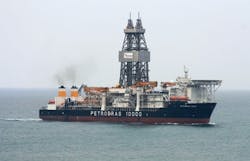As parts of the US and elsewhere experience one of most relentless winters on record, it's only human nature to entertain thoughts of warmer-weather activities, such as walking along a sandy beach or even taking in a splash-filled day at a water park. One thought that probably won't occur to bathers at a particular water park in the Pfalz town of Landau in Germany, however, will likely be: "How is all this water being heated?"
That's because this summer, German oil and gas producer Wintershall will be providing that town's La Ola municipal water park with warm water and heating that is generated by geothermal power from a former crude oil reservoir about 1,100 m underground.
Wintershall, a BASF subsidiary, reported that 22,000 l./hr of water will be circulated within a closed loop system at La44, a decommissioned production well that is one of 75 wells operated by the company in the Landau region.
Before the well can be used for geothermal power, however, technical modifications will have to be made, the company said.
The heated water for the park will be pumped to the surface via the tubing string at the decommissioned well. A heat pump and four heat exchangers will then supply the leisure pool, which is just 500 m away, via a district heating pipe. "This cooperation will provide us with over 1 million kw-hr of environmentally friendly energy for a year," explained Thomas Hirsch, managing director of Stadtholding Landau in der Pfalz GMBH, the town's operating and holding company.
Location, location, location
It's Landau's location in the Upper Rhine Plain that offers ideal conditions for tapping geothermal energy, said Thomas Ruttmann, head of Wintershall's Landau operations. "With deep drilling, the temperature increases by an average of 4.7° every 100 m," he said, adding that this is considerably higher than the average increase in temperature of 3°/100 m elsewhere. "That's why there are a relatively high number of geothermal projects in the Landau region compared to other regions," he said.
In order to develop the former La44 oil well, the current concessions three shareholders—Wintershall, ExxonMobil Production Deutschland GMBH, and Internationale Tiefbohr GMBH & Co. KG—have teamed with EnergieSudwest AG subsidiary Lan Tec GMBH, which specializes in the use of renewable energy and also already serves as operator of several district heating networks in the Pfalz region.
Landau is home to the largest crude oil field on the Upper Rhine Plain, Wintershall said. The field is comprised of eight blocks on which a total of nearly 200 wells have been drilled. Production from Landau started in 1955, the same year the field was discovered with the Landau 2 well. Since then, more than 4.3 million tons of oil have been produced in Landau.
CO2 reduction benefit
Wintershall, which holds a 50% share in the concession, also recently took over as operator. In addition to supplying the water park, the production operations in Landau currently use more than 13 million kw-hr of geothermal heat energy by treating the reservoir water. The energy generated this way is equivalent to the average consumption of more than 350 households.
With each German household responsible for about 13 tons/year of carbon dioxide emission, this means a reduction of more than 4,500 tons/year of CO2, Wintershall calculates.
Chances are good, however, that this thought, too, won't cross the minds of many of the water park's attendees this summer.
Only, "Pass the sunblock."
More Oil & Gas Journal Current Issue Articles
More Oil & Gas Journal Archives Issue Articles
View Oil and Gas Articles on PennEnergy.com



